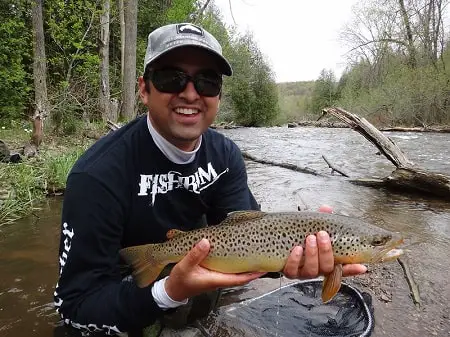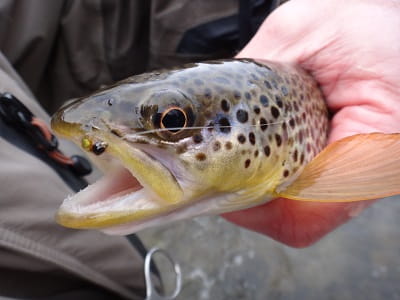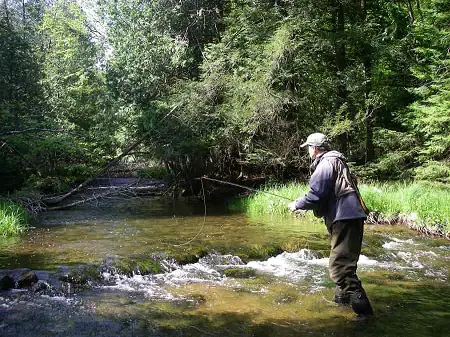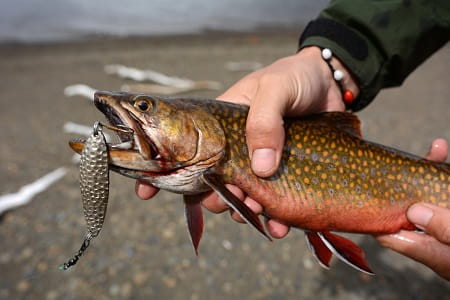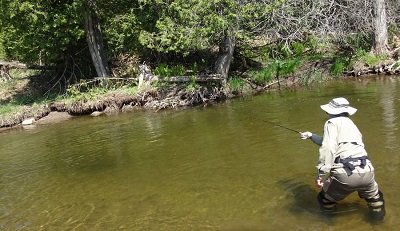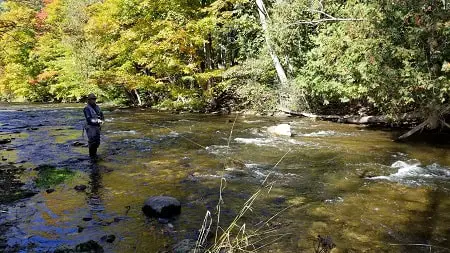Trout Fishing: The Most Complete Guide To Catch More Trout
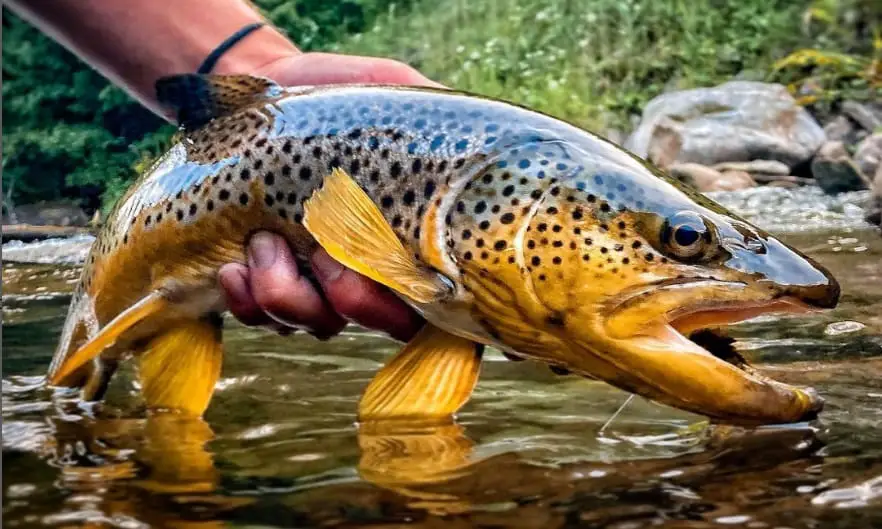
I’m a veteran fishing guide with over 37 years of experience. I have stood beside and taught thousands of people how to catch trout properly. This is what you need to know, and with us, you know that all the information comes from experienced trout guides who live and breathe fishing.
Trout fishing changes throughout the season because the trout’s feeding habits change based on water temps, oxygen, cover, food, and spawning. I and other guides know this and adapt and change with the trout so we keep catching fish.
Do what guides do, use what guides use, ignore the bad information all over the internet, and you will catch a lot more trout.
About Trout Fishing
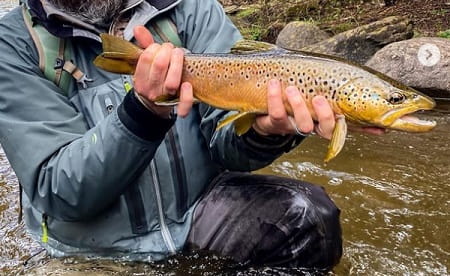
Fishing for trout can be done anywhere that trout live, including lakes, ponds, reservoirs, streams, and rivers, and I will discuss them all here.
I use different methods based on the type of water I am fishing.
Common Trout Species
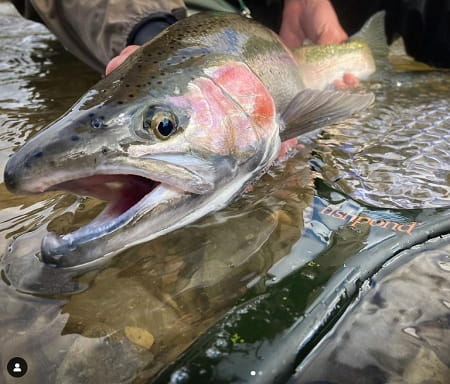
There are many common trout species around the world.
Rainbow Trout: The world record is 21.77 kg (48 lbs. 0 oz.).
Brown Trout: The world record is 19.08 kg (42 lbs. 1 oz).
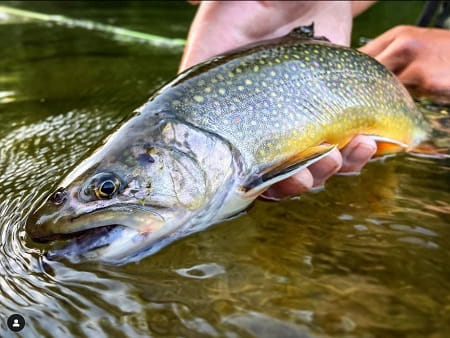
Brook Trout: The world record is 6.57 kg (14 lbs. 8 oz.)
Cutthroat Trout: The world record is 18.59 kg (41 lbs. 0 oz.)
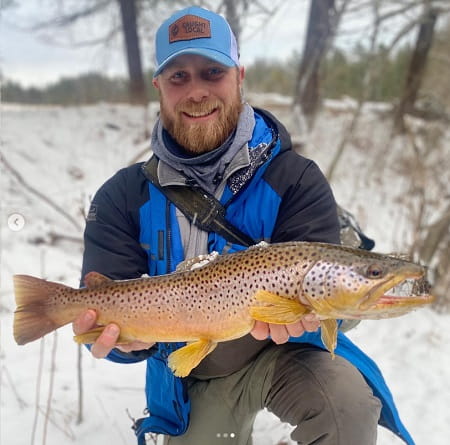
Bull trout: The world record is 14.51 kg (32 lbs. 0 oz.)
Lake trout: The world record is 32.65 kg (72 lbs. 0 oz.)
Steelhead Trout – The all-tackle world record steelhead is 36 pounds.
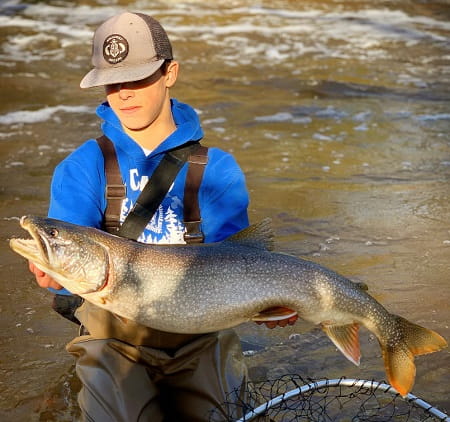
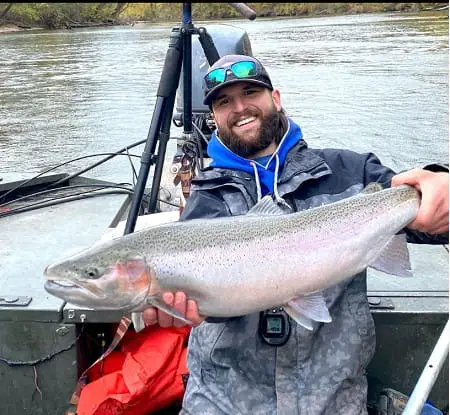
How To Fish For Trout
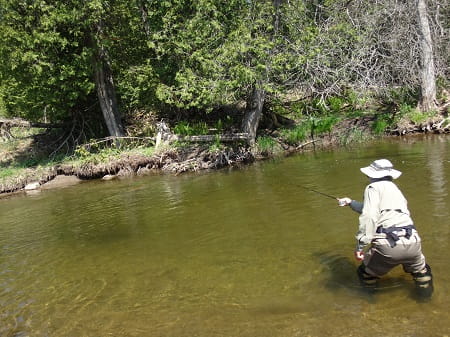
I use many methods used to catch trout on lakes or trout streams.
Common fishing methods for trout include the use of a spinning reel with a bait fished under a float or by casting lures.
- Lure Fishing: Casting lures works very well in lakes and streams of all sizes. Lures like spoons, spinners, and crankbaits are best.
- Float Fishing / Bobber Fishing: Float fishing is a very popular and effective method and is used to suspend a bait in the water column. This is very common in both lakes and rivers.
- Plunking: Plunking is a still fishing method that puts your weight and bait on the bottom while you wait for trout to swim past and grab it. No bobber is used and this method can be used in lakes or rivers.
- Drift Fishing / Bottom Bouncing: The drift fishing and bottom bouncing methods are very similar. These methods allow the angler to fish a bait in a river without the use of a bobber.
Where To Fish Trout, And When To Fish Trout
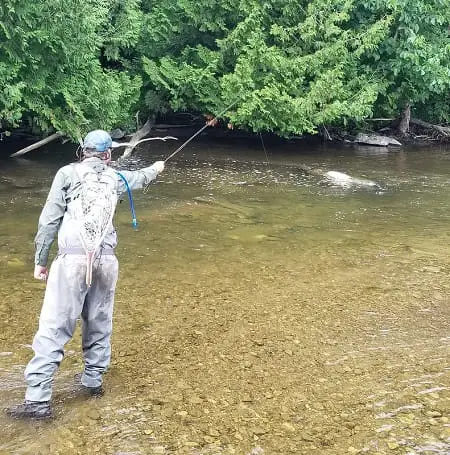
If you want to catch fish, you first need to know where to go and when to fish.
Trout require cold water, clean water, well-oxygenated water, and food. In some cases, trout will also seek out structure, but that is not a mandatory requirement. Find these areas and you will find trout.
Trout prefer small creeks and rivers but are also found in lakes and ponds.
Finding Trout In Lakes, Ponds, And Reservoirs
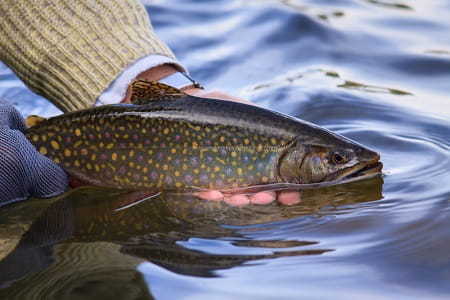
Still, waters like lakes, reservoirs, and ponds can have trout in them, and often, the trout will be found where the water temperatures are suitable for the trout’s survival, as well as where the food is.
Trout will often be found near the surface in the spring and deeper in the lake during the rest of the year. They will also feed near river mouths in the spring and fall.
If available, structures like rocks, shoals, and sunken trees will attract fish in lakes. They will either use the structure to hide near or feed near.
Trout in lakes will also feed on emerging and floating insects, so you may find trout near gravel areas where these insects reside. They will also feed on baitfish. Check out my articles:
- Reservoir Fishing For Trout: Guide Tips And Tactics
- Fishing Trout In Ponds: A Complete Guide
- Trout Methods and Tactics For Lakes: A How To Guide
Finding Trout In Rivers And Streams
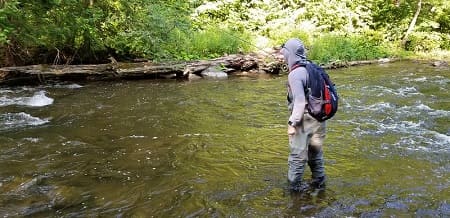
River fishing for trout is my specialty.
I look for undercut banks, places with optimal food sources, feeding lanes, current seams, the mouth of tributary streams, and structures like logs, and rocks.
During the summer, pocket water and shallow rapids can be very good spots because they are well oxygenated.
Deep holes are often a magnet for big trout, especially in low clear water or in the winter when the trout are cold or resting. During high sun, the trout will often seek out structure and depth.
Fishing For Stocked Trout
Local fisheries will add hatchery trout to many ponds, some lakes, and some rivers to improve fishing. This is known as stocking fish, and it’s mostly done in late winter and early spring.
Often, these hatchery fish are easy-to-catch fish if you know where they are and the methods for fishing for stocked trout. Stocked trout are a favorite for many anglers and kids.
Often, stocked waters will have extended fishing rules, harvest limits, and year-round fishing, so check your local fishing regulations.
Fishing For Wild Trout
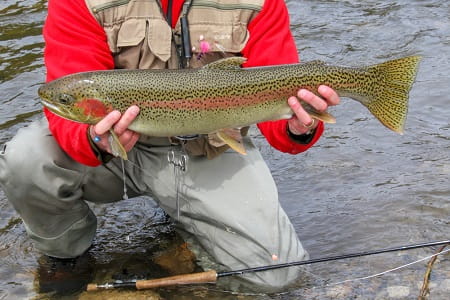
Wild trout are often found in cold creeks and rivers where naturally reproducing trout populations thrive.
Rainbow trout and browns are the most sought-after wild trout in North America.
Often, wild trout fisheries will have open and closed seasons, so check the fishing regulations for your area before you head to your local streams.
Spring Fishing
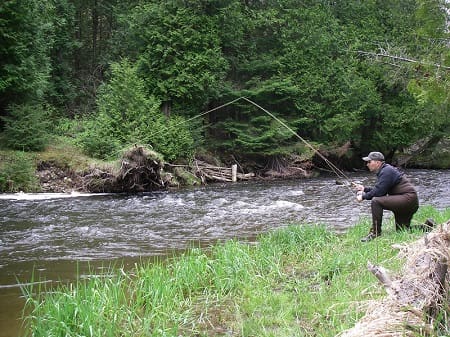
Many anglers regard springtime as the best time to fish for trout, and for good reason.
Many trout are hungry after the long cold winter, and with ideal water temperatures and increased bug activity will have the trout actively feeding.
I discuss this more and discuss the best fishing methods, best times, and best baits and lures for Spring Fishing on another page.
Summer Trout
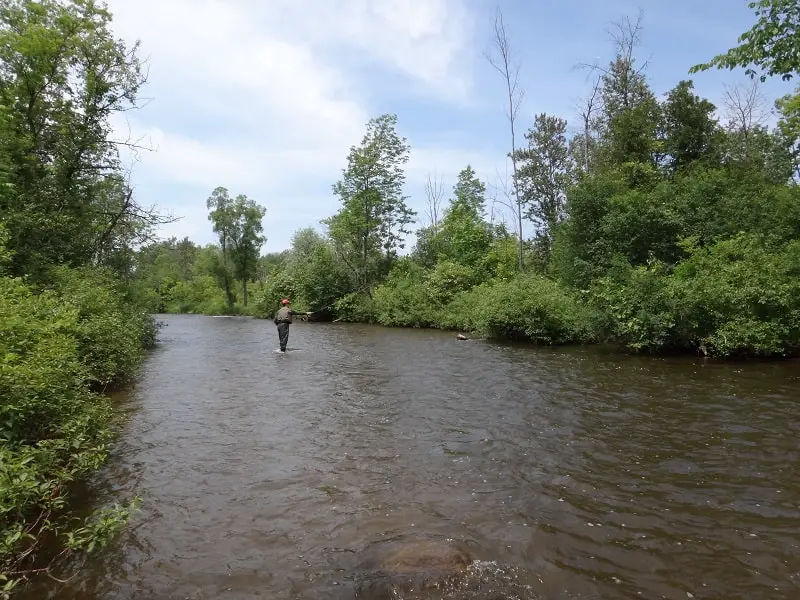
Cool streams, cold creeks, and tailwater rivers are often the best places to target trout when the weather is hot.
Some streams will warm up too much during the day, therefore, the best fishing will be overnight and the first few hours after dawn when the water is coolest.
This is also when the insects will be most active which also activates the trout. Often, trout will seek out faster more oxygenated water on colder creeks. It’s best to follow my tactics and tips for Trout In Hot Weather.
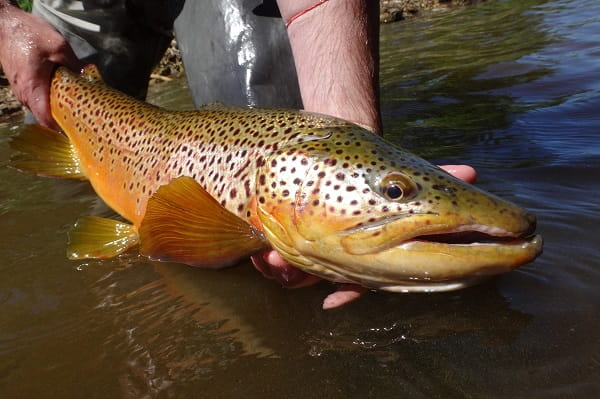
Summer is also a time for low clear water, so smaller baits and a stealthy approach is best.
Fishing for trout at night can also be good, but ensure you know my tactics and safety tips for trout at night in the dark.
For more on catching trout in the summer, check out these articles.
- Summer Trout Tactics For Rivers
- Late Summer Trout Tactics
- Best Time To Fish For Trout In Summer: 4 Best Times
Fall Fishing
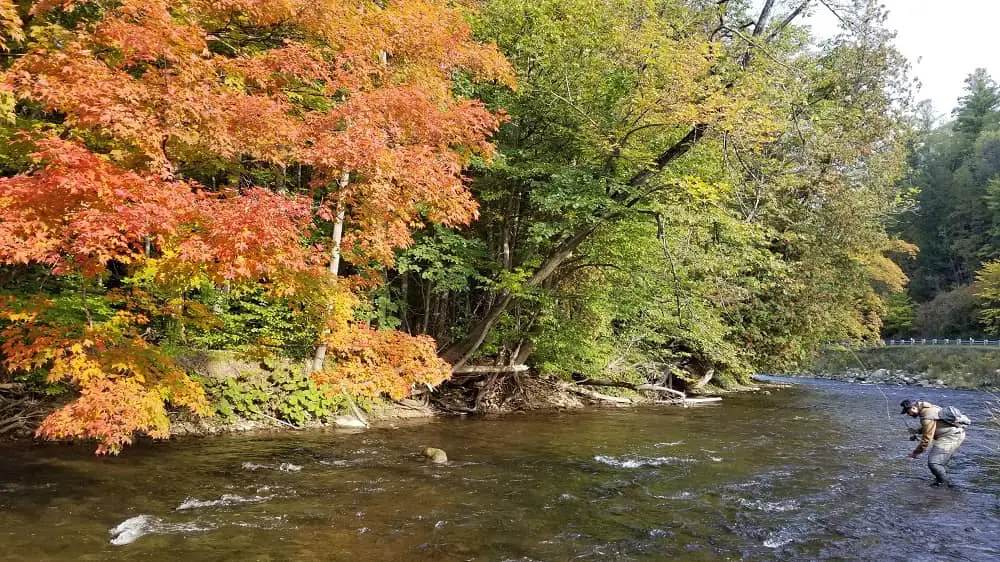
Fall is one of my favorite times to target trout.
The trout are often feeding heavier in the fall to prepare and fatten up for winter and they are willing to grab a bait or lure.
If there are salmon, steelhead, or browns in your local river, a bait like spawn sacs is a very good choice.
Winter Fishing
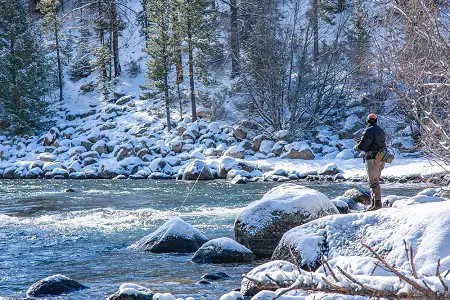
Winter is when the anglers disappear, but, the trout are still there, and for guides like me that know how to fish trout in the winter, lots of trout can be caught.
When winter river fishing for trout, the key to catching them is to slow your presentation down, use smaller lures and a smaller bait, and fish deep holes where the trout concentrate in the winter.
I discuss this on my winter fishing page.
The Best Trout Tackle and Gear
I have a huge list of essential and non-essential gear that my guides and I recommend to my clients.
Trout Rod and Reels
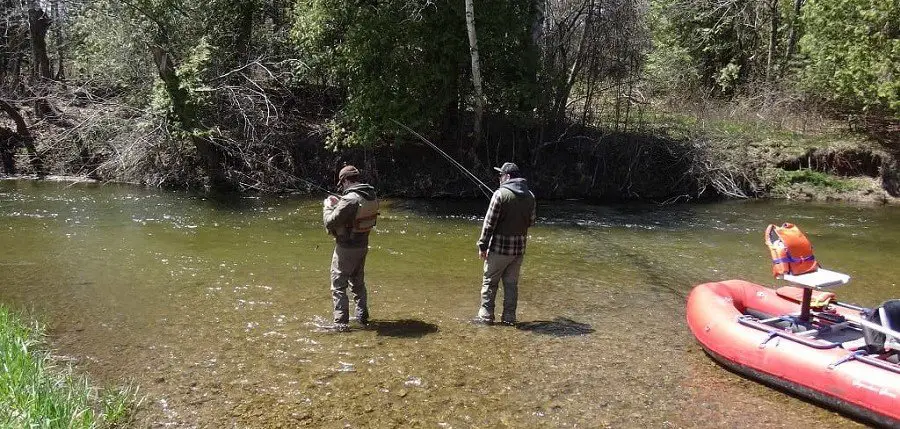
Most fishing for trout is either done with a spinning reel and rod, or a fly fishing rod and reel. Some anglers will also use baitcasting reels.
Spinning reels in sizes 15 to 20 (1500 to 2000) are the most popular for fishing with bait or casting lures.
A light to a medium-light 7-foot rod is a normal trout rod size. However, there are some methods and situations along the river that might require a shorter or longer rod. I discuss this on my page Best Rods For Trout.
I discuss the best spinning reel for trout on my page Best Gear For Trout.
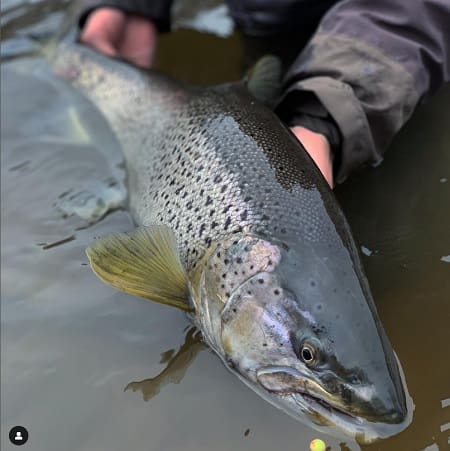
- Fishing Line: I use four to 6 pound monifilament line, or 10 to 20 pound braided line.
- Leader: when bait fishing, I use a 2 to 6-pound fluorocarbon leader. When using lures on braided line I use a fluorocarbon leader of 8 to 12 pounds.
- Weights: When I’m fishing trout, I use split shots that are dark grey or almost black, and I use the ones without the little wings that are meant to help you take them off. DO NOT use shiny silver weights.
Check out: The Best Fishing Line For Trout: What The Guides Use and What Pound Test Leader For Trout.
Nets
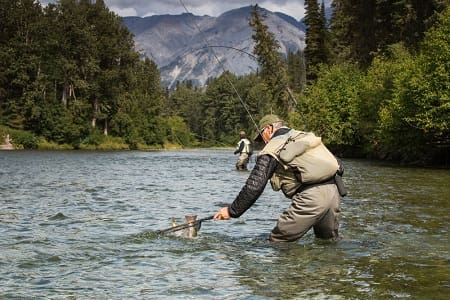
I’ve heard way too many stories of guys losing huge trout simply because they didn’t have a net. You should always use a net.
Check out my favorite lake nets and wading nets for river fishing.
Trout Bait Hooks
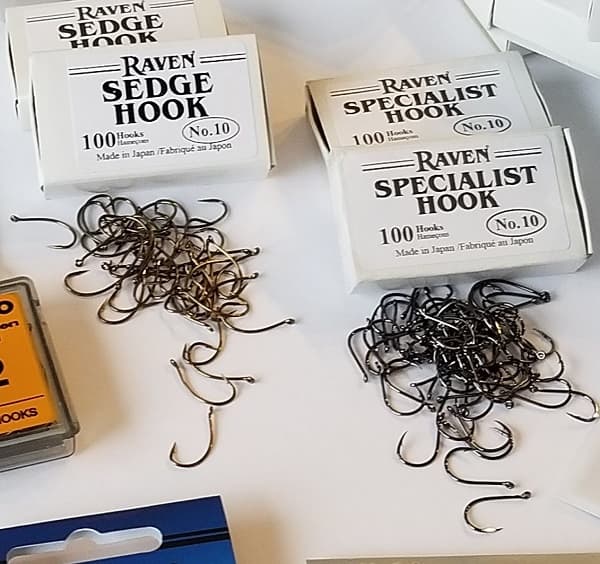
Guides use specific hooks that are short shank, wide gap, and have razor sharp points. They use these because they are proven to hook well and they hold the fish well.
Generally, a size 8 or 10 Raven Specimen or Gamaktsu Octopus hook will work for almost all trout situations.
You must use the right size hook for your bait, and for the size of the trout in the areas you fish.
See Hook Size For Trout and Best Trout Hooks.
A treble hook is for lures, not for bait, so don’t use them for bait fishing.
Best Knots For Trout
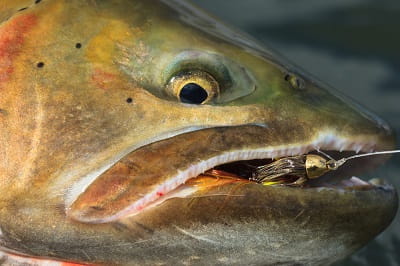
There are only 2 or 3 knots that you need to know for trout.
I use the improved clinch knot or the double Davy knot for most of the fishing I do.
If you use a braided line, consider the Palomar knot and the uni knot.
I discuss my favorites on my page Trout Knots Every Angler Should Use and Fly Fishing Knots For Beginners: Top 4 That Fly Guides Use.
Fishing Techniques For Lakes and Ponds
If you are planning on fishing trout in a lake, there are different techniques you should use.
- Lure Fishing – Casting a lure from shore, or from piers or docks.
- Bait Fishing – Casting a bait from shore, or from piers or docks is a common method.
- Boat Fishing – Casting a lure or trolling from a boat are also good methods.
Focus your fishing around structure, fish the depths where the trout’s preferred water temperatures are, and use a fish finder/sonar unit to help you locate baitfish, structure, and the trout. See: 11 Best Fish Finders: Review And Buyers Guide
Bait Fishing For Trout In Lakes and Ponds
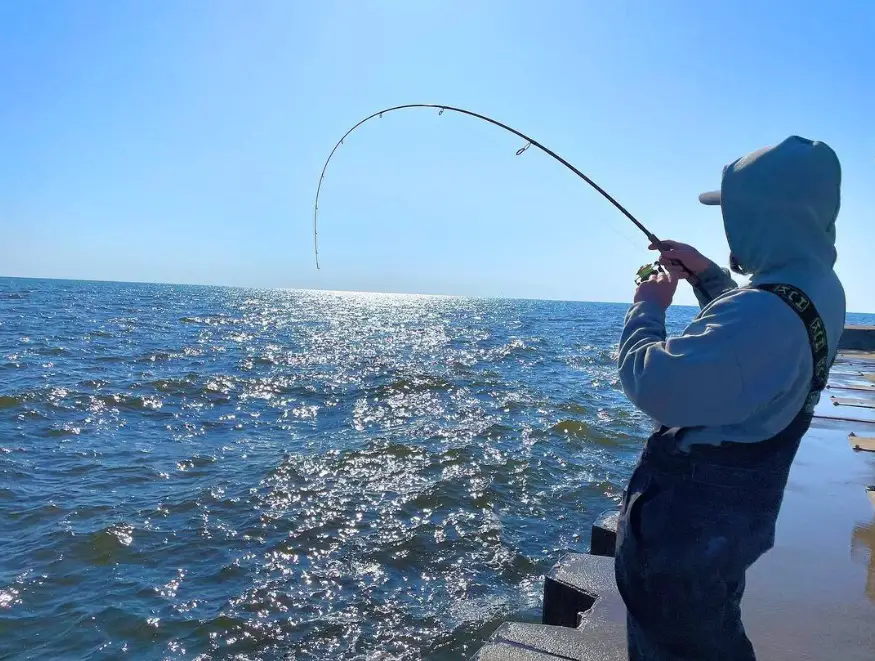
I do not recommend artificial baits for still fishing on a lake unless the trout are stocked.
Natural and live baits like minnows, leeches, or maybe salmon eggs are the best baits.
Use methods like float fishing with slip floats or a method called plunking.
Plunking For Trout
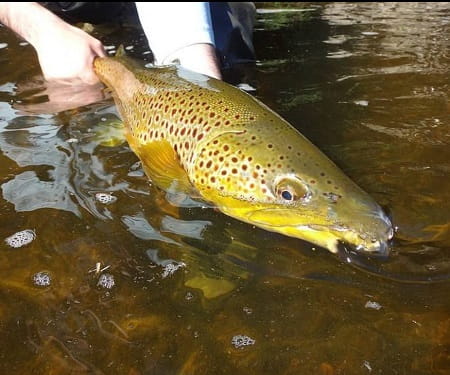
Plunking is a method of still fishing used in still water, lakes, or moving water with slower currents.
The idea is the bait rig is cast out and allowed to sink and held on the bottom with a large weight. You put light tension on the line and then sit and wait. You watch your rod tip, and if it starts twitching or bouncing, you set the hook.
Lure Fishing For Trout In Lakes and Ponds
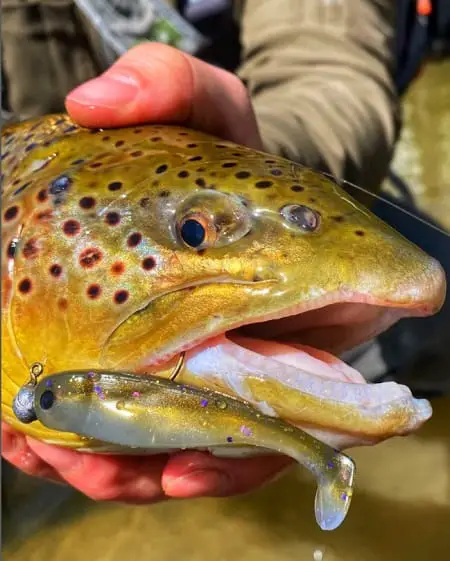
Artificial lures are the most common way to fish a lake and are often the best way to catch trout.
Casting artificial lures such as crankbaits, spoons, spinners, and jigs using spinning reels can be good when fishing from shore or from a boat.
Check out Lure Fishing For Trout and The 31 Best Lures For Trout which is where I tell you the best lures for all situations, the best sizes, and the best colors, based on my 36 years of experience catching trout on lures.
Trolling For Trout
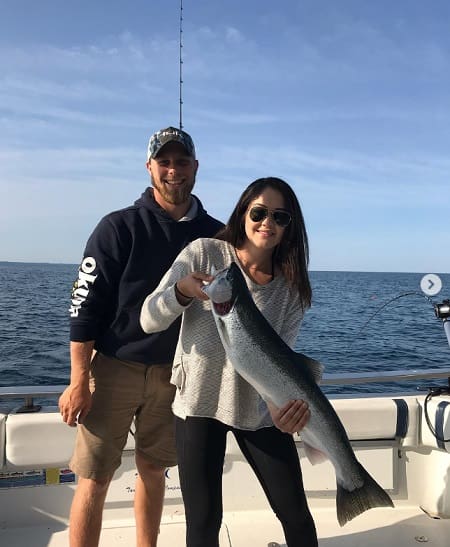
Trolling for trout is mostly done when fishing lakes. Anglers will troll with lures or bait rigs using a flat line method or with the aid of either dipsy divers or downriggers to get the desired depths.
When flatlining I really like a 20 to 30-pound braided line with a 16 to 36-inch 10 to 12-pound fluorocarbon leader.
I discuss this on my page Trolling Methods For Trout.
Best Lures For Trolling For Trout
- Trolling spoons and Williams Wobblers spoons in silver, gold, bronze, and brighter flashy colors- Lure size is 3 to 4 inches.
- Spinners are good lures to troll – silvers, golds, and copper colors are good, and brighter colors are also good. Best in sizes 3 to 5 are good options.
- Crankbaits are good for trolling – 3 to 5 inches is best.
Fishing Techniques For Rivers And Streams
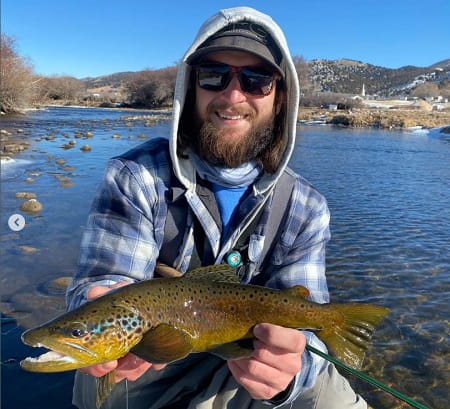
Fishing techniques for a trout stream will depend on many factors including what your favorite technique for catching trout is.
As an example, when I’m fishing slow-moving water it is best to use the float fishing method.
But when I am fishing in fast and deeper water, I catch more fish when drift fishing.
For many anglers, spin fishing methods are top on the list, and I discuss them on my page Spin Fishing For Trout.
Bait Fishing For Trout In Rivers and Streams
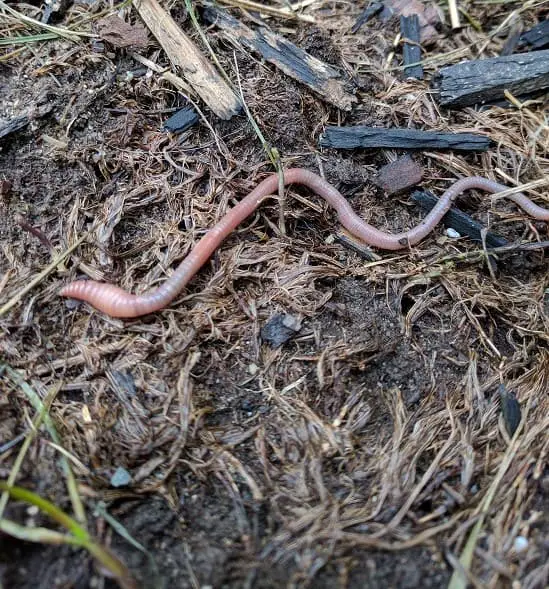
Bait fishing in rivers is a great way to catch trout, the bait can be fished under a bobber, or free-drifted.
Baits can be flies, minnows, artificial baits, and even a jig suspended below a bobber.
There are two types of baits. High percentage baits and low percentage baits. I discuss both on my page Best Baits For Trout.
Lure Fishing For Trout In Rivers And Streams
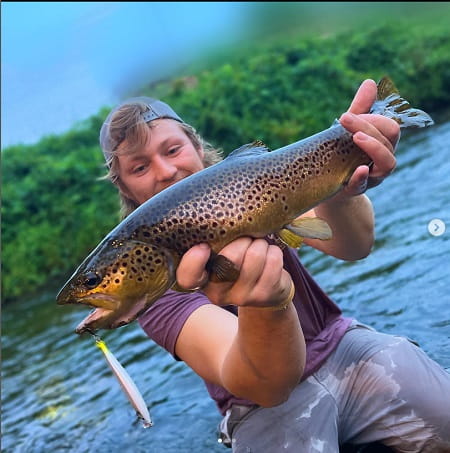
Lure fishing is great for catching all trout species in streams.
I have found spinners, spoons, and crankbaits are best, and I will adjust my retrieve to suit the activity level of the trout.
GUIDE TIP: I have found that a more erratic retrieve almost always gets more bites, so I will twitch and bounce all my lures, including lures meant to run straight like spinners and spoons.
For best results, I recommend casting at about a 45-degree angle across and downriver and then let your lure swing across the river and broadside to the trout.
Best Lures For Trout In Rivers
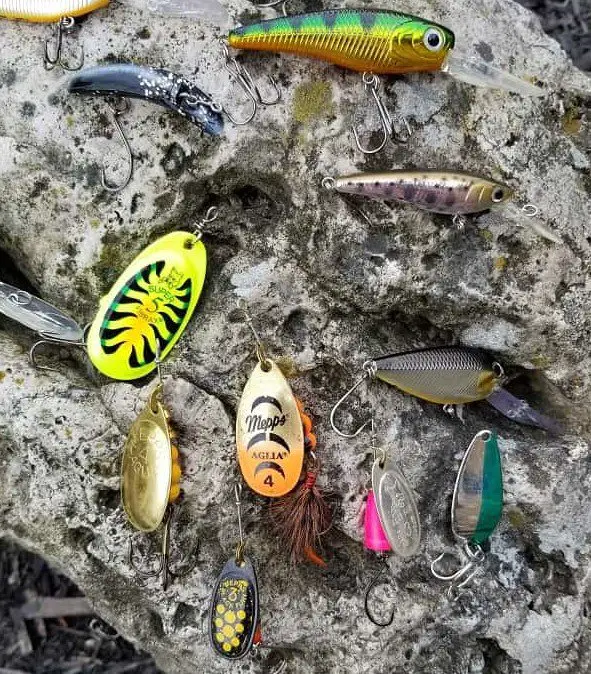
I also cover the water effectively by spreading out each cast and retrieving about 3 to 5 feet apart, working my way downstream.
Even smaller fish will hit lures, so I always have a variety of sizes from 1.5 inches to 4 inches long.
Browns and bows will also smash larger 4 to 6-inch lures like crankbaits.
Line For Lure Fishing Rivers
I recommend a good 10 to 20-pound braid like Berkely Fireline. In very clear water, I will often add a 16 to 30-inch fluorocarbon leader attached by a swivel, especially when using braid or mono.
Float Fishing For Trout
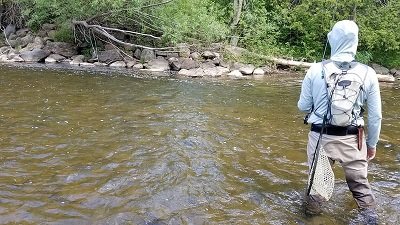
Float fishing is one of my most effective methods.
With this method, a bobber (also known as a float) will suspend my bait below the float as it drifts down the stream.
I have found that when float fishing, I can effectively drift worms, artificial flies, jigs, minnows, crayfish, and spawn.
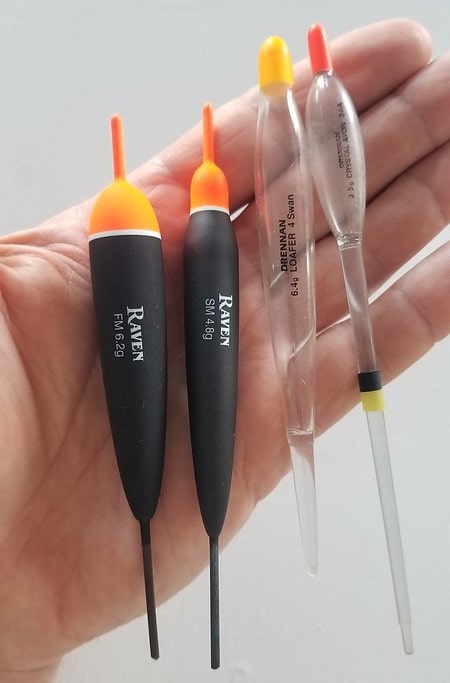
Just be sure that if you are going to be float fishing, you use floats that are meant for river fishing.
I have found that some floats are not very good for river fishing.
A good river float does more than just detect a bite. A good river float will aid in finding the right depth as well as help control the speed of the bait, which are both critical to success.
Float fishing can be greatly improved if you implement the four fundamentals that I teach my clients and discuss on my float fishing pages. I will tell you the best floats, and the most effective leader setups and baits that I and other trout guides use on my page Float Fishing For Trout – An Expert Guides Best Tips.
Centerpin Fishing For Trout
Centerpin fishing is basically the same as float fishing, except you are using a specialized reel called a Centerpin reel.
I can honestly say that Centerpin fishing is much more effective at catching fish than float fishing with other reels. See more at Centerpin Fishing For Beginners: 20 Steps From A Top Guide.
Bottom Bouncing For Trout
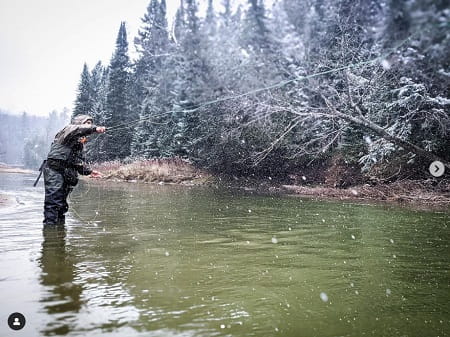
I love bottom bouncing for trout because it is the most effective way to fish bait for trout in shallower water under three feet deep, and when fishing in pocket water sections or in faster sections.
I show you how this method on my page Bottom Bouncing – 5 Proven Guide Tips For More Fish.
Drift Fishing For Trout
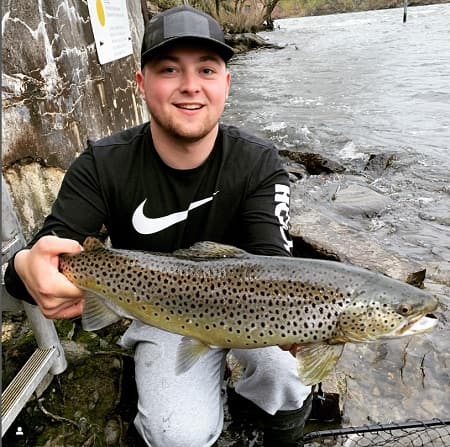
Drift fishing is very much like bottom bouncing, just on a bigger scale, and it’s much better for bigger sections of rivers, deeper water, and faster water.
I discuss drift fishing in more detail, along with the best baits, hooks, rods, and reels, and, even show you my leader setup in my article Drift Fishing: Best Methods, Set-ups, And Best Baits.
Bobber Doggin For Trout
Bobber Doggin is a relatively new method of fishing with a bobber that is becoming more popular with the steelhead and salmon anglers of the West Coast, and now some trout anglers are trying it in their streams.
I have used this method and know that it can work for all species of trout. Check this method out at Bobber Doggin: Trout, Steelhead, And Salmon Tactics
Fly Fishing For Trout
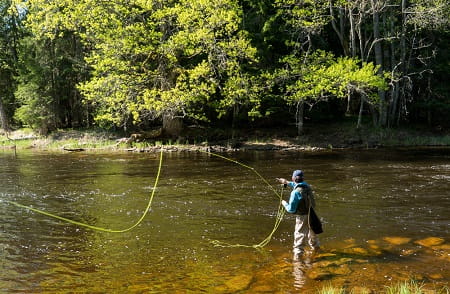
Fly fishing for trout is used by a lot of river guides. It is my preferred method for fishing for trout in rivers, especially in certain types of water.
And since aquatic insects are a large portion of many trout’s diets, you can easily imitate these aquatic insects with fly fishing.
Fly fishing includes methods like:
- Nymph Fishing
- Dry Fly Fishing
- Wet Fly Fishing
- Streamer Fishing
- Euro Nymphing
Be sure to check out my article Fly Fishing For Trout.
There are plenty of great flies for catching trout, and the flies that I use will depend on the method and the conditions.
Keeping Fish And Storing Trout While Fishing
In many parts of the country, anglers fish trout so they can eat them. If you are keeping fish, be sure that you know the legal limits.
Many anglers will hold and transport their fish in a plastic bag. Some prefer a basket known as a Fishing Creel.
Releasing Fish
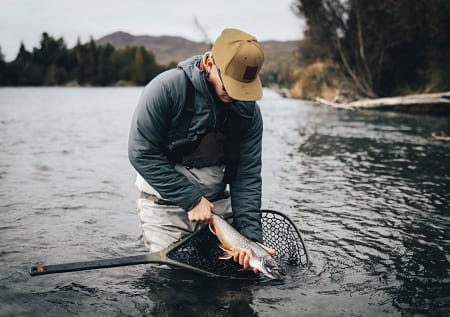
Releasing fish, which is also known as catch-and-release fishing, is a great way to keep your local fisheries healthy, and it allows larger fish a chance to spawn and make more fish.
Get yourself a good trout net, and use it! See 5 Best Trout Nets And A Guides Advice On How To Attach Them
License Requirements and Fishing Regulations
Most areas will have rules and requirements for fishing trout. In some areas, there are trout seasons, there might also be harvest limits, and you will require a fishing license. You may even be required to have a trout tag or trout stamp.
Before you fish be sure you check your local area fisheries department to be sure you know the rules and have a valid fishing license.
#1 Presentation
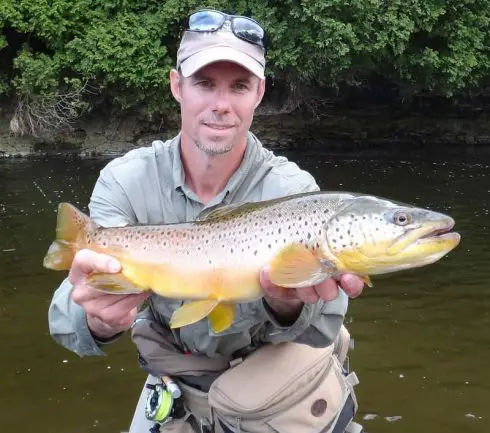
Some say presentation is the key to catching trout, but I only partially agree. Presentation is how you present your bait or lure to the fish. You want to imitate the natural food source as best as possible, and there are a few key elements to a great presentation.
#2 Approach
You could have the best presentation in the world, but if you approach the river in a way that the big trout see you, you will spook them, and your presentation will be practically useless. Therefore, ensure you approach the trout in a way that does not spook them.
This approach varies depending on the type of water and the methods you are using.
#3 Stealth
Just like the approach, not letting the trout hear you can be critical to catching trout. I see far too often guys rushing into a pool and spooking every big trout in that pool before they even make their first cast. Slow down, stay low, and stalk the trout like you were hunting, and you will catch far more trout.
#4 Speed Control
Probably the most critical part of your presentation is controlling the speed of your bait when fishing currents.
Your bait needs to be drifting down the river at the same speed as all the natural food sources that the trout see. I discuss this in more detail on my page Controlling Your Speed For More Fish When Float Fishing
#5 Depth
Getting your bait and lure close to the trout is important, because, often the trout will be close to the bottom of the stream or pond.
Learn to get your bit down if you want to catch more trout.
#6 Cover the water
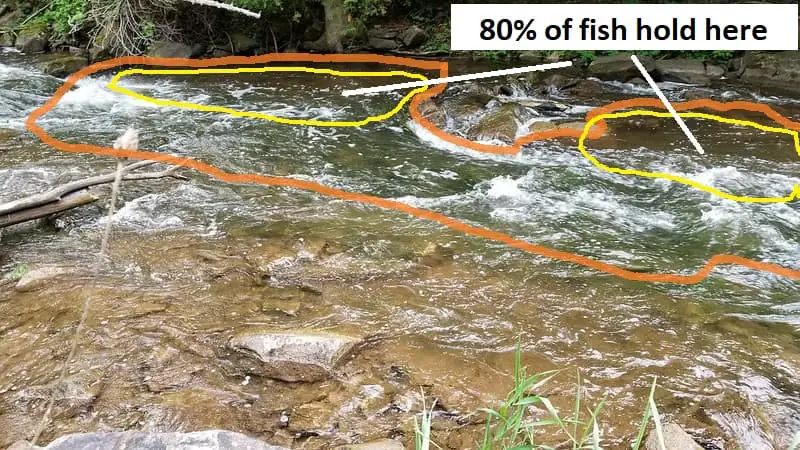
Covering the water is something many guys do not do well, whether they are fishing in a river or a lake, or pond.
You need to learn to read the water and then cover all the parts of the water effectively and thoroughly if you want to maximize how many fish you catch.
I discuss this in my article Effectively Covering The Water When Float Fishing.
If you liked this, check out the full article, which provides in-depth detail on all the aspects of fishing for trout, and includes a lot more information and more tips from guides. See the full article HERE.
Tight Lines
Graham
Resources:
(PDF) Nutrition and Feeding of Rainbow Trout (Oncorhynchus mykiss) (researchgate.net)

